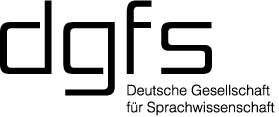DGfS 2022 – AG10
Discourse obligates – How and why discourse limits the way we express what we express.
Tübingen, February 23–25, 2022
Invited speaker
Hannah Rohde (University of Edinburgh)
Organizers
Robin Lemke (Saarland University)
Lisa Schäfer (Saarland University)
Heiner Drenhaus (Saarland University)
Ingo Reich (Saarland University)
Workshop description
It is common knowledge that discourse determines to a large extent the way we express what we want to express. In theoretical linguistics, this insight has been described primarily in terms of information structural notions like topic, focus and common ground (CG): The CG includes all the information that both speaker and addressee (mutually) take to be given, and given information is deaccented or even a candidate for omission. While new information typically pushes to the right, old information tends to be realized to the left. There is, however, an alternative approach to account for the way we as speakers choose between several possible encodings of a meaning in a given context, an approach that builds on Shannon information, the notion of predictability (surprisal) and the idea that information is distributed as uniformly as possible across a linguistic utterance. The latter idea is the basis of Fenk-Oczlon’s (1989) argument that less informative expressions are expected to precede more informative ones (since they contribute to their predictability), which derives the background-focus split. This information-theoretical approach is becoming increasingly popular (e.g. Levy & Jäger 2007) and has been successfully applied to phenomena as diverse as word order, complementizer deletion, the realization of discourse connectives, VP ellipsis, topic drop, and fragments (see e.g. Lemke et al. 2020). One needs to be aware of the fact though that two fundamentally different notions of information are at stake here: semantic information in the case of information-structural approaches, and occurrence probabilities in the case of information-theoretical approaches. In this workshop, we want to invite theoretical as well as experimental papers from both camps in order to start a lively discussion, which focuses on the question whether the two different perspectives relate to each other in an interesting way.
References: • Fenk-Oczlon, G. (1989): Word frequency and word order in freezes. Linguistics 27, 517–556. • Levy, R. & Jaeger, T. F. (2007): Speakers optimize information density through syntactic reduction. In: Schölkopf, B. et al. (eds.), Advances in Neural Information Processing Systems. Cambridge, MA: MIT Press. 849-856. • Lemke, R. et al. (2020): Script knowledge constrains ellipses in fragments – evidence from production data and language modeling. In: Proceedings of the Society for Computation in Linguistics, volume 3.
DGfS 2022
For more information on the 44th Annual Conference of the DGfS, please visit the website of the conference.

